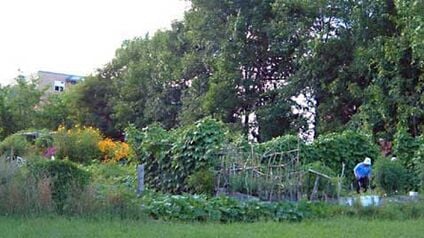
This article is a spin-off from CASwiki's Food activism page. Separate spin-off articles cover Food activism resources and Food news.
Allotment gardening[edit | edit source]

The Luxembourg-based Office International du Coin de Terre et des Jardins Familiaux, representing three million European allotment gardeners since 1926, describes the socio-cultural and economic functions of allotment gardens as offering an improved quality of life, an enjoyable and profitable hobby, relaxation, and contact with nature. For children, gardens offer places to play and to learn about nature, while for the unemployed, they offer a feeling of doing something useful as well as low-cost food. For the elderly and disabled, gardens offer an opportunity to meet people, to share in activity with like-minded people, and to experience activities like planting and harvesting. W
Alternate wetting and drying[edit | edit source]
 Is it time to choose sustainable rice?, Wicked Leeks (Jul 17, 2023) — You might not know it, but traditional rice cultivation emits serious levels of greenhouse gases. Clare Hargreaves interviews a man working with rice farmers to get climate-friendlier rice onto British dinner plates.
Is it time to choose sustainable rice?, Wicked Leeks (Jul 17, 2023) — You might not know it, but traditional rice cultivation emits serious levels of greenhouse gases. Clare Hargreaves interviews a man working with rice farmers to get climate-friendlier rice onto British dinner plates.
Alternate wetting and drying (AWD) is a water management technique, practiced to cultivate irrigated lowland rice with much less water than the usual system of maintaining continuous standing water in the crop field. It is a method of controlled and intermittent irrigation. A periodic drying and re-flooding irrigation scheduling approach is followed in which the fields are allowed to dry for few days before re-irrigation, without stressing the plants. This method reduces water demand for irrigation and greenhouse gas emissions without reducing crop yields.
Bioregional cookbook[edit | edit source]
- How to write a cookbook for your bioregion

This is the How-To guide for Locally Delicious. Please contact us the authors/editors of Locally Delicious: Recipes and Resources for Eating on the North Coast at info@locally-delicious.org for a more thorough discussion of our process, struggles, and recommendations for putting together this type of collaborative community project.
see also: Bioregional cookbook, Locally Delicious - The book
City farms[edit | edit source]
City farms are usually community-run projects in urban areas, which involve people interacting and working with animals and plants. They aim to improve community relationships and offer an awareness of agriculture and farming to people who live in built-up areas.
They vary in size from small plots on housing estates to larger farms that occupy a number of acres. It is estimated that more than three million people visit city farms each year and around half a million people work on them as volunteers. Although some city farms have paid employees, most rely heavily on volunteer labour, and some are run by volunteers alone. Others operate as partnerships with local authorities. W
Community fridge[edit | edit source]
A community fridge is a refrigerator (colloquially "fridge") located in a public space. Sometimes called freedges, they are a type of mutual aid project that enables food to be shared within a community. Some community fridges also have an associated area for non-perishable food. Unlike traditional food pantries, these grassroots projects encourage anyone to put food in and take food out without limit, helping to remove the stigma from its use. The fridges take a decentralized approach, often being maintained by a network of volunteers, community members, local businesses, and larger organizations. Food in community fridges is primarily donated by individuals or food rescue organizations and can be sourced from a variety of places. Major grocers like Trader Joe's and Whole Foods donate large amounts of excess foods to food rescue organizations that then donate to these fridges. The food donated would have otherwise been thrown out.
The main aim of community fridges is to reduce food insecurity, while also mitigating food waste. They enable people facing hardship to have easy access to fresh, nutritious food. Fridges offer a wide range of food from canned goods to fresh produce to pre-cooked meals. Pre-cooked meals are required to be labeled when donated. Many fridges also accept household items, sanitary goods, and during the COVID-19 pandemic, offered masks and other PPE. Community fridges can also serve as social spaces that enable people to connect to their communities; Shelterforce magazine notes that "community fridges seem to have discovered a sweet spot in service delivery: close enough to feel the warmth of shared humanity, but far enough to avoid a sense of resentment or burden." Many fridges also painted by from local artists.
Community gardening[edit | edit source]

Community gardens are shared spaces for growing food. Typically each member has a plot in which to grow their own food.
As we teach ourselves and each other how to grow food, we build community and resilience, and eat better.
Sometimes, some gardeners specialize in growing the plants that they know well, and trade with other members. This is especially practical where people from different ethnic groups share a garden, as they often have completely different skills and knowledge.[1] In this way diversity is valued as an asset and bonds of social capital are created within the local community.
Community gardens are especially useful for apartment dwellers, and others without much of their own space to grow food.
For the "how to", see How to start a community garden.
Community gardens provide fresh produce and plants as well as satisfying labor, neighborhood improvement, sense of community and connection to the environment. They are publicly functioning in terms of ownership, access, and management, as well as typically owned in trust by local governments or not for profit associations. W
Community-supported agriculture[edit | edit source]
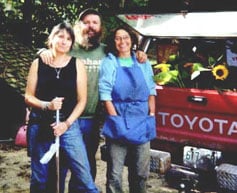
Community-supported agriculture or community-shared agriculture (CSA) is type of agriculture in which local individuals commit to buy seasonal produce of a farm for a whole year and also agree to share the risk of failed harvests (in years where some produce fails, you don't get this type of produce).
consists of a community of individuals who pledge support to a farm operation so that the farmland becomes, either legally or spiritually, the community's farm, with the growers and consumers providing mutual support and sharing the risks and benefits of food production. Typically, members or "share-holders" of the farm or garden pledge in advance to cover the anticipated costs of the farm operation and farmer's salary. In return, they receive shares in the farm's bounty throughout the growing season, as well as satisfaction gained from reconnecting to the land and participating directly in food production. Members also share in the risks of farming, including poor harvests due to unfavorable weather or pests. By direct sales to community members, who have provided the farmer with working capital in advance, growers receive better prices for their crops, gain some financial security, and are relieved of much of the burden of marketing.
It is a form of local support for agriculture. Subscribers pre-pay a farmer to grow the desired produce. Sometimes the farmer will select what is to be grown, sometimes the buyer selects what they want to buy, more often it is a cooperative arrangement between the two parties.
Community-supported fishery[edit | edit source]
A community-supported fishery (CSF) is an alternative business model for selling fresh, locally sourced seafood. CSF programs, modeled after increasingly popular community-supported agriculture programs, offer members weekly shares of fresh seafood for a pre-paid membership fee. The first CSF program was started in Port Clyde, Maine, in 2007, and similar CSF programs have since been started across the United States and in Europe. Community supported fisheries aim to promote a positive relationship between fishermen, consumers, and the ocean by providing high-quality, locally caught seafood to members. CSF programs began as a method to help marine ecosystems recover from the effects of overfishing while maintaining a thriving fishing community. W
Food cooperative[edit | edit source]
A food cooperative or food co-op is a food distribution outlet organized as a cooperative. Food cooperatives are usually consumers' cooperatives where the decisions regarding the production and distribution of its food is chosen by its members. Food cooperatives follow the 7 Cooperative Principles and typically offer natural foods. Since decisions about how to run a cooperative are not made by outside shareholders, cooperatives often exhibit a higher degree of social responsibility than their corporate analogues. W
Forest gardens[edit | edit source]
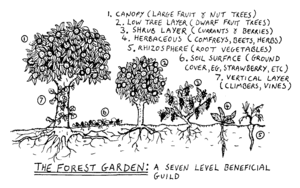
Forest gardens (also termed food forests, or edible forest gardens) are form of sustainable agriculture that mimics natural woodland ecosystems. All the plant species in a forest garden are of direct or indirect benefit to humans. The main yields are edible food crops, along with lesser produce such as plants used for fiber, timber or medicine.
Forest gardening involves polyculture planting, ideally to create mutually beneficial relationships between neighboring plants (guilds). Sustained by the delicate yet powerful balance of natural living cycles, the multiple layers of a forest garden provide for each other the same way the layers of a natural forest do. In this regard, forest gardening fosters biodiversity. Careful planning will also take into account the succession that may take place in the forest garden system.
Some plants are used to attract beneficial insects or birds. Others work to nitrogen fixation, build soil, or simply help keep out weeds. Vines on trees, shrubs, add another layer of growing space for edible fruits such as kiwi and passion fruit. Plants support one another as they store energy in their roots for later harvest and winter storage and when properly arranged help retrieve and disperse deep lying nutrients for each other.
The various existing forest gardens around the world can be categorized by age (recent or established) or by the climate (temperate, arid, or tropical).
It is an ancient form of agriculture that has been practised in some parts of the world since prehistory. The term forest gardening was coined by Robert Hart in the 1980s, after which the technique was adopted by key figures in the establishing permaculture community. At present, forest gardening has grown in popularity, and the theory and knowledge base has been substantially expanded by proponents within the permaculture community and other dedicated experts.
Garden sharing[edit | edit source]
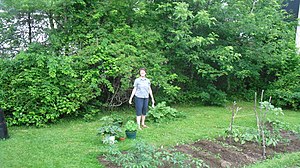
Yardsharing arrangements can be made between friends, neighbors, families or unrelated groups. It is a decision to garden and grow food together. Yardsharing groups gather to share time, resources, space and skills in order to lower cost of food, lower miles that food travels to plate, teach kids about growing food and to make neighborhoods livable again.
Garden sharing is a local food and urban farming arrangement where a landowner allows a gardener access to land, typically a front or back yard, in order to grow food. This may be an informal, one-to-one relationship, but numerous Web-based projects exist to facilitate matchmaking. In some cases, garden sharing projects are launched as a way to shorten community garden waiting lists that are common in many cities. W
Gleaning or Food rescue[edit | edit source]
Gleaning is the act of collecting leftover crops from farmers' fields after they have been commercially harvested or on fields where it is not economically profitable to harvest. Some ancient cultures promoted gleaning as an early form of a welfare system. W
Food rescue, also called food recovery, is the practice of safely retrieving edible food that would otherwise go to waste, and distributing it to those in need. Organizations that encourage food recovery, food rescue, sharing, gleaning and similar waste-avoidance schemes come under the umbrella of food banks, food pantries or soup kitchens. W
Guerrilla gardening[edit | edit source]
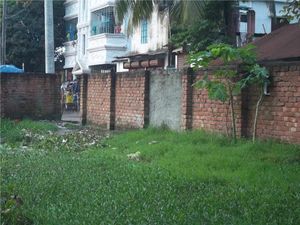
 ‘I call it botanarchy’: The Hackney guerrilla gardener bringing power to the people, theguardian.com (Sep 28, 2023)
‘I call it botanarchy’: The Hackney guerrilla gardener bringing power to the people, theguardian.com (Sep 28, 2023)
Anyone can become a guerrilla gardener. If you fancy quietly filling a barren urban landscape with greenery, have a go. Many people guerrilla garden in order to...
- Create an "urban foodscape" and allow for foraging.
- Increase local food security (an important part of resilience) and self-sufficiency.
- Show or investigate how easily food can grow in underused places
- Make a political statement, similar to very informal community gardening
- Reclaim urban land for public use and public good
- Bringing back food-growing skills, and restoring plant life to over-developed areas.
- Ease the decline of the industrial food system and geographically dislocated food supply systems.
- Make the place they live more beautiful
- Have fun!
Incredible Edible Town[edit | edit source]
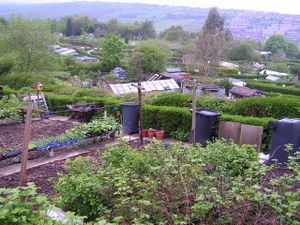
Six years ago, a woman in a small town called Todmorden, at the back end of a Yorkshire valley in the north of England, dug up her prize rose garden. She planted vegetables, knocked down the garden wall, and put up a sign saying "Help Yourself".
Today, Incredible Edible Todmorden has changed that town. There are herb tubs at the railway station, raised beds at the police station. The canal towpath is lined with edible plantings. Outside the health center, patients can pick healthy fruit and medicinal plants.
But that's not all. There are now 50 Incredible Edible groups across the UK and around 300 in France. More are popping up all the time, from Montreal to Mali. People worldwide are making connections and changing the way they think about food.
So how can your town become Incredible Edible? Here are some steps you could take:[2]
Organise food events[edit | edit source]
Examples include:
- Celebratory feasts such as harvest festivals or just social gatherings centred around a meal: a potluck, bring and share food, or a potlatch, see United States#Free stuff
- Free Compost Give Away Day
- Solar Cookout, for example Sustainable NE Seattle's Second Annual Solar Cookout!
Regenerative agriculture[edit | edit source]
Regenerative agriculture is a conservation and rehabilitation approach to food and farming systems. It focuses on topsoil regeneration, increasing biodiversity, improving the water cycle, enhancing ecosystem services, supporting biosequestration, increasing resilience to climate change, and strengthening the health and vitality of farm soil.
Regenerative agriculture is not a specific practice itself. Rather, proponents of regenerative agriculture use a variety of sustainable agriculture techniques in combination. Practices include recycling as much farm waste as possible and adding composted material from sources outside the farm. Regenerative agriculture on small farms and gardens is often based on philosophies like permaculture, agroecology, agroforestry, restoration ecology, keyline design, and holistic management. Large farms are also increasingly adopting regenerative techniques and often use "no-till" and/or "reduced till" practices.
As soil health improves, input requirements may decrease, and crop yields may increase as soils are more resilient against extreme weather and harbor fewer pests and pathogens.
Regenerative agriculture mitigates climate change through carbon dioxide removal, i.e. it draws carbon from the atmosphere and sequesters it. Along with decreasing carbon emissions, carbon sequestration practices are gaining popularity in agriculture, and individuals and groups are taking action to fight climate change.
School-community kitchens[edit | edit source]
School-Community Kitchens Concept Paper, Center for Ecoliteracy
Seed library[edit | edit source]
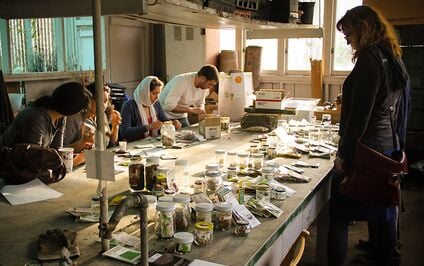
A seed library is an institution that lends or shares seed. It is distinguished from a seedbank in that the main purpose is not to store or hold germplasm or seeds against possible destruction, but to disseminate them to the public which preserves the shared plant varieties through propagation and further sharing of seed. Seed libraries usually maintain their collections through donations from members, but may also operate as pure charity operations intent on serving gardeners and farmers. A common attribute of many seed libraries is to preserve agricultural biodiversity by focusing on rare, local, and heirloom seed varieties. W
External links
- Organic Seed Alliance
- the seed library social network
- seedlibraries.net
- Sister Libraries, worldwide seed lending libraries listings
Seed swap[edit | edit source]
Seed swaps can be arranged online or by mail, especially when participants are spread out geographically. Some events are organized as part of an educational effort, where visitors are taught gardening and growing skills and how to preserve an area's cultural heritage and biodiversity. W
Seedy Sunday[edit | edit source]
Seedy Sunday or Seedy Saturday is a catchphrase used for seed swap events that bring the public together with seed savers, to maintain and develop the open pollinated and heritage crop cultivars that are a resource in a community. In some communities the event is a gardening show or may feature local chefs using the heritage plants and seeds. The titles Seedy Saturday and Seedy Sunday are dedicated to the public domain by the event founder Sharon Rempel..[citation needed]
The heart of a Seedy Sunday or Seedy Saturday event is the swapping and sale of seeds or other propagation material for public-domain plant cultivars that that have been preserved or developed by individuals or families. These may not require high-input agriculture, and are variously described as landraces, folk varieties, farmer varieties and heritage seed. Sharing information about the social, cultural and culinary aspects of the seed is an important part of heritage seed saving around the world. Providing education about techniques for seed-saving, small-scale agriculture and horticulture, and about local, national and international laws that affect public-domain crop plants can also be an important part of the event. W
Other community action projects[edit | edit source]
see also: How to's
- Abundance schemes to collect and share food using bicycle trailers
- Community allotments
- Community Farm Land Trusts
- Community greenhouse, eg see Food news#2013
- Community harvest related events, eg community apple juicing
- Community orchards
- Farmers markets, set one up or support most local ones
- Bulk buy schemes
- Fruit tree mapping
- Gardening clubs, eg for specific types of gardening: organic, permaculture, etc.
- Gardening match up service
- Healthy eating initiatives
- Local Foodshed Mapping
- Local recipe collections
- Seed saving and sharing
- Sharing cooking skills, for example with younger people or younger parents
- Slow food initiatives
- Support wider initiatives such as Meat Free Mondays
- Visit an organic farm
See also[edit | edit source]
- Food activism resources
- Food news
- Food security
- Food Sovereignty
- Young and beginning farmers
- Portal:Food and agriculture
- Agroecology
- A People’s Food Policy, a series of (UK) articles
- Biodiversity
- Ethical consumerism
- Free stuff
- Localism
- Sharing
- Community land trust
local information can be found, or shared, via our many location pages
- ↑ An example of in the Western suburbs of Sydney was described in the Sydney Morning Herald a few years ago (ref?)
- ↑ 10 Steps Toward an Incredible Edible Town, December 3, 2013, By Julian Dobson, Shareable

